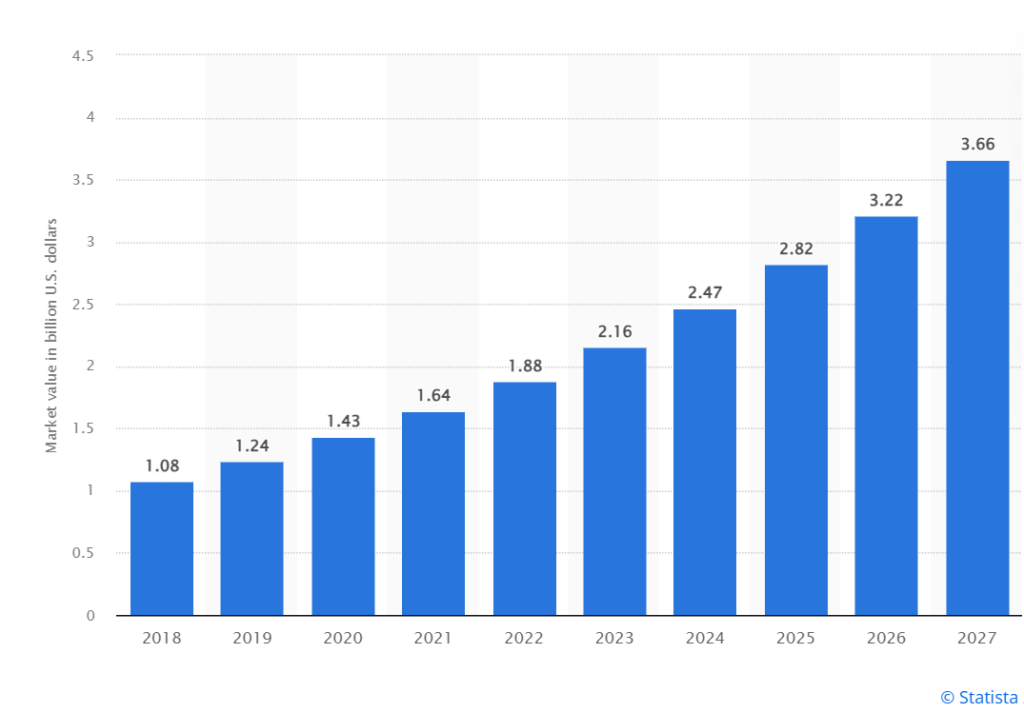
A virtual data room (VDR) is a helpful tool for sharing highly sensitive data with third parties. The popularity of virtual data rooms is only growing due to increasing data security concerns in times of global digitalization.
In this piece, we dwell on how the global virtual data room market functions now and what virtual data room trends to expect in 2024.
Factors that impact the VDR market
To start with, the virtual data room market is steadily evolving, and we back up this statement with figures further.

But now, let’s first take a look at the main factors that shape the modern VDR market and force its growth and development:
- Technological advancements. Innovations in cloud computing, encryption, and data security technologies drive the evolution of virtual data rooms, allowing for more robust features and enhanced user experiences.
- Regulatory compliance. Strict data protection regulations such as GDPR and HIPAA require virtual data room providers to ensure compliance features within their platforms. This significantly impacts the growth of the virtual data room market.
- Mergers and acquisitions activity. Though the M&A industry is experiencing a certain lethargy phase now, M&A transactions are still conducted globally. This, in turn, fuels the demand for VDRs, with companies seeking secure platforms for due diligence processes.
- Globalization of business. As businesses expand globally, the need for secure and efficient platforms to share sensitive information across borders becomes imperative. It drives the demand for VDR solutions with multi-language support and international data hosting capabilities.
- Economic conditions. Economic factors such as interest rates, investment trends, and market volatility impact corporate activities like fundraising, IPOs, and restructuring. This indirectly influences the demand for VDRs as companies seek secure platforms for financial transactions and secure data management.
Geography of the VDR market
The use of virtual data room solutions is common in many countries around the globe. However, experts define four main regions of virtual data room software popularity: North American, European, Asia-Pacific, and LAMEA region.
Let’s briefly review the main insights of the VDR market dynamics in each of them:
- North American. The North American virtual data room market comprises the US and Canada and is the biggest VDR market in the world (the United States hold the largest market share). It’s forecasted to grow at a CAGR of 10.6% by 2031. Virtual data rooms are mostly used in the BFSI industry (banking, financial services, and insurance) to securely conduct complex M&A deals and ensure secure data sharing.
- European. Though the European region isn’t leading in the global VDR market share, it is developing rapidly. By 2031, the European market is expected to grow at a CAGR of 13.8%. Though European users currently prefer on-premise solutions over cloud-based, it’s likely to change significantly in the near time. This is especially relevant due to the implementation of several government rules and requirements which will increase the need for secure data sharing and management.
- Asia-Pacific. Asia Pacific virtual data room market includes China, Australia, India, Japan, and other countries of Asia-Pacific region. A large number of appearing startups are likely to drive the further adoption of virtual data rooms in this region.
- LAMEA. LAMEA region includes Latin America, the Middle East, and the Africa virtual data room market. The demand for virtual data room solutions in this region is lower compared to other regions due to lower financial activities happening there. However, it’s still expected to grow as part of global digitalization and cloud computing, which brings the need for secure online data storage that can ensure 100% data protection.
Top segments of the virtual data room usage
So, who are the most common users of virtual data rooms? Let’s list the top industries/use cases where VDRs are used:
- M&A. Virtual data rooms are mostly used in M&A during due diligence and other stages of the M&A process. Despite a considerable decrease in M&A activity over the last few years, M&A experts see strong signs of its rebound in 2024, which can speak about the growth of the demand for virtual data room solutions.
- IPO. During IPOs, VDRs help companies comply with regulatory requirements by securely sharing financial, legal, and operational documents with underwriters, regulators, and legal advisors.
- Fundraising. Virtual data rooms provide startups and investors with an opportunity to facilitate due diligence processes during fundraising rounds and establish transparent investor relations. Just like with M&A, the fundraising (private equity and venture capital) sector is forecasted to experience an upturn — 53% of investors believe that 2024 will pick up in terms of investment pace.
- Audit and compliance. Virtual data rooms streamline the audit process by providing auditors with secure access to financial records and other relevant documentation. What’s more, they help to maintain compliance with regulatory requirements by securely storing and sharing sensitive corporate information.
- Board communications. 89% of board directors acknowledge the importance of digitalization in all business growth strategies. That’s why virtual data rooms are widely used by boards of directors to share board materials, meeting minutes, and other confidential documents with board members.
- Corporate data storage and management. Regardless of an organization size and business function, VDRs serve as centralized repositories for storing and managing corporate documents, such as contracts, agreements, and policies. The use of virtual data rooms ensures that all users have access to the most up-to-date versions of documents and tracking changes over time.
Popular data rooms
Overall rating:
4.9/5
Excellent

Overall rating:
4.8/5
Excellent

Overall rating:
4.7/5
Excellent
Virtual data room market trends in 2024
The global virtual data room market size was valued at $1.84 billion in 2023. It’s projected to grow at a CAGR of 15% in the forecast period from 2024 to 2030 and reach $4.26 billion.
Let’s briefly review the main drivers for virtual data room industry development.
Rising adoption of cloud computing
Statista’s market research shows that the global cloud storage sector is growing steadily. According to the market overview, it’s estimated at $108.69 billion in 2023 and is projected to grow at a CAGR of 23% by 2030 and reach $472.47 billion.
Such a growing adoption of cloud-based solutions across industries contributes to the expansion of the VDR market.
Stringent data privacy regulations
With the enforcement of data privacy regulations like GDPR, CCPA, and similar laws worldwide, organizations seek tools like VDRs to ensure compliance with data protection requirements. Virtual data rooms offer top-notch security features such as encryption, access controls, and audit trails, helping companies protect sensitive information during transactions and collaborations.
AI advancements
Recent data indicates that 30% of dealmakers view AI and machine learning as key elements driving the evolution of the M&A landscape over the forthcoming five years. Such a demand for AI-driven solutions within M&A is reflected in the virtual data room sector, too.
Many virtual data room providers already offer certain AI-driven functionalities, and their number, as well as the range of AI services offered, will expectedly grow.
Growing awareness of cybersecurity risks
The latest Ernst & Young study on America’s board priorities demonstrates that 64% of board directors see cybersecurity as the top concern. Indeed, the average cost of data breaches is too high to ignore — it was $4.45 million in 2023.
This drives the demand for a solution that offers secure online data storage and efficient data sharing in one place, such as a virtual data room.
Top 3 VDR market leaders
Now, let’s take a brief look at the top VDR market players in 2024:
| Provider | Top features | Free trial |
| Ideals | 8 levels of access permissions Advanced Q&A workflows Auto-notifications Detailed audit trails In-app live chat support In-built redaction | ✅ 30 days |
| Intralinks | Multi-project management AI-redaction Detailed reporting Zoom integration Real-time activity insights | ❌ No |
| Datasite | 5 levels of access controls Mobile app Two-factor authentication Remote wipe Advanced search Document labels | ✅ 14 days |
Key takeaways
- The virtual data room market is growing steadily and is projected to reach $4.26 billion by 2030.
- Among the main drivers for VDR demand and global market growth are the rise of cybersecurity risk awareness, the adoption of cloud computing, AI advancements, and stringent data privacy regulations.
- The largest VDR market share is held by the North American sector.
To choose the best virtual data room provider for your business needs, explore the selection of the top vendors on our main page.


